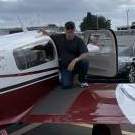What fuel flow are you seeing with takeoff power setting? Assuming 280hp (full throttle, full rich, 2500 rpm at sea level), in my experience if it's less than about 23.5 GPH (per Mooney) it's set too low. CMI says 22.5 max but that's a little low, my guess is to make fuel consumption numbers look better (see Continental M-16 and Mooney MAN161).
If you can lean it out in cruise and get significantly lower CHTs with smooth operation then it's likely a fuel setup problem.
Previous owners of my plane were based in Glenwood Springs CO at 5916 MSL, and the logs indicate that they had been messing with the fuel flow, maybe to lean it out at idle. I'm based in Santa Fe NM at 6349 MSL and never saw max power CHTs above 400 around here, but in Texas that first summer they got up to 430-440 full rich, which got my immediate attention. I never saw numbers like you're seeing.
The first shop that did the fuel pressure/flow setup for me still set it low, but it was an improvement. When Maxwell did the 310 hp upgrade they got it right IMO and there's plenty of fuel now to keep CHTs comfortably lower during takeoff and climb-out from sea level.
In cruise I operate LOP and my CHTs are between 270 and 330 with cyl. 5 always hottest.
If you do buy the plane and find you need to adjust the fuel pressure/flow, I suggest you employ someone who is very familiar with the Continental/Mooney-specific fuel setup procedure.




